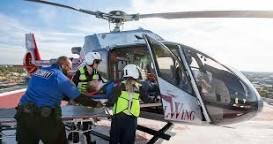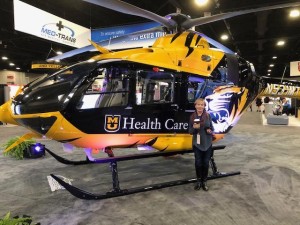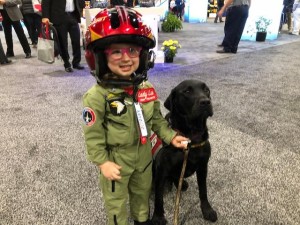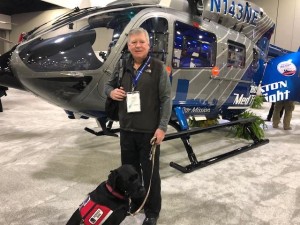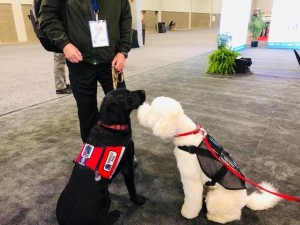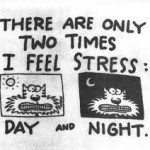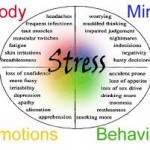Nov
27
TRAUMA AND FIRST RESPONDERS
Filed Under Courage, Events, First Responders, Healing, Life, PTS, PTSD, Service Dogs, Stress, Tears of a Warrior, Trauma | Comments Off on TRAUMA AND FIRST RESPONDERS
By Janet J. Seahorn, Ph.D.
Two weeks ago Tony, Trooper, and I had the honor of being part of the annual Air Medical Transport Conference (AMTC) in Atlanta, Georgia. This conference was attended by pilots, flight crews, physicians, nurses and first responders from all over the world. The convention was filled with individuals who have given and continue to give much of their lives to saving and helping others. Many have served in the military, and many have been overseas in combat zones. To say they are an inspiration to our communities is an understatement. We were able to meet and talk with several individuals who shared their stories with such humility and purpose dedication. Like our military, these first responders serve their communities with courage and tenacity. They are with others at the most traumatic time of life. They comfort, attend to injuries, and all too many times are the last person a victim sees at the time of death.
I was asked to be the keynote speaker for this amazing group. Of course, my presentation was on trauma and how it affects both our minds, bodies, and spirits. It was the first time a keynote speaker at this event was requested to speak on the topic of trauma and Post-Traumatic Stress (PTS). As in countless organizations, Post-Traumatic Stress is often the elephant in the room that most don’t want to discuss and sometimes even acknowledge. Its presence is seen and felt, yet, little is done to heal and attend to the many traumatic experiences our first responders deal with every day.
To say I was both incredibly nervous and honored to be the keynote is an underestimation of my concerns. I researched, practiced, and prayed for several months prior to the event hoping that the information in the keynote would make a difference to those attending.
I used the analogy of a “sheepdog”. In September we were in Steamboat Springs, CO and watched a mixture of nine Border Collies, Great Pyrenees and Akbash sheepdogs meander behind their one-thousand herd/flock of sheep as they moved from summer range in the National Forest. These dogs are incredibly protective of their herd – keeping the herd together and fighting off predators at the peril of their own lives. They look so normal in their big, furry, white bodies, but make no mistake; they are ferocious in the task of watching over their sheep. Our first responders are like these sheepdogs. They protect, tend to, and put their lives at risk for their communities. The question I raised, just like with our military and veterans, who takes care of the sheepdogs?
As a society, it is our duty to make sure those who take care of us are taken care of as well. They see, hear, touch, smell, and feel events that most of us will never encounter. The burdens they carry are too often only theirs and held in the silence of their minds and hearts. Like our military and veterans many believe that if they are traumatized by their experiences, they are somehow inadequate, less fearless, and not as capable of doing their jobs. This is totally inaccurate. One cannot function in a career of trauma without having some effects on his/her own well-being. In fact, this is what makes them more compassionate and effective at their jobs.
A few statistics I learned while doing my research:
- 34% of first responders have Post-Traumatic Stress;
- Barely half of first responders have had any training into how to deal with their own trauma;
- Much like our military, first responders have a much higher suicide rate than the average population;
- Female critical nurses in ICU and flight nurses are four times more likely to developed ovarian cancer than their peers;
These are just a few of the statistics that should make us all concerned and ready to share the responsibility of taking care of those who take care of us.
Just like our military and veterans – “If we send them, then we MUST mend them.”
KEYNOTE SPEAKER:
Janet J. Seahorn, Ph.D.
Dr. Seahorn has been a classroom teacher and administrator for forty years. She has taught as an adjunct professor for Colorado State University and several universities in the Denver area. For the last ten years she has been teaching a class on Neuroscience and Learning at Colorado State University. Jan has a BA in English/Elementary Ed., an endorsement/license in middle school education and administration, a MA in Gifted and Talented, and a Ph.D. in Human Development and Organizational Systems. Her background includes an in-depth understanding of neuroscience research and effective instructional practices, organizational systems and change. She conducts numerous workshops on the Neuroscience of Learning & Memory Systems and the effects of “at-risk” stress environments on brain development.

Dr. Seahorn co-authored the award-winning book with her husband, Tears of a Warrior: A Family’s Story of Combat and Living With PTSD. The theme focus is on trauma and how it can impact the brain, body, and emotional development of an individual. Much of the research focused on Post-Traumatic Stress (PTS) and understanding how to identify and work with first responders and veterans who have experienced trauma and associated stress. She and her husband Tony work extensively with military personnel, veterans, first responders and families on how trauma impacts the brain. She also works with schools and communities on how trauma experienced in childhood through abuse, neglect, and other environmental conditions impact learning and behavior.
She has written two other books, When Crap Happens Grow Zucchini: A Book on How to Live with Dying and Appreciate the Crap
Foul Wisdom: Identifying the Turkeys and Eagles in your Organization and Life
A third illustrated book on her PTSD poem, Silent Scream, is currently in production.
Dr. Seahorn’s TED Talk on post-traumatic stress can be viewed on You tube: https://www.youtube.com/watch?v=BEHDQeIRTgs&feature=youtu.be
Janet and Tony have two adult sons, Chad and Christopher who enjoy living and working in the Rocky Mountain Region. Tony & Janet share their home with two Black Labradors, Trooper – a certified service dog, and Brody, a puppy being trained as a therapy dog to work in children’s court systems, hospitals, and schools. The family enjoys travel and outdoor activities: history, geography, hiking, fly-fishing, rafting, snow skiing and anything that puts them in touch with nature. Janet also volunteers with several animal shelters in Colorado.
May
25
EVERY WAR HAS TRAUMA
Filed Under Combat PTSD, Healing, Memorial Day, Post-Traumatic Stress "Injury", PTSD, Stress, Tears of a Warrior | Comments Off on EVERY WAR HAS TRAUMA
by Janet J. Seahorn, Ph.D
Every so often we get asked a question about why past war veterans like those from World War II seemed not to suffer as greatly from Post-Traumatic Stress. Our answer is that “they did” but as in all past wars very few knew what they were experiencing or how to talk about such a silent wound. Who would understand their despair? Who would judge them for being inferior, less courageous? How could they talk about what they were suffering when there were no words/names to this despondency?
Once again, one of our friends sent us an article by Duane Jeffrey, an emeritus professor of biology at Brigham Young University. The article was titled, “Mental Malfunction in Mankind’s Wars. The author gave some staggering statistics about World War II veterans both American, British, and even German troops. It made me wonder, not that these veterans were troubled by Post-traumatic Stress, but that they somehow were able to move forward each day not ever knowing or understanding what was happening to them.
When we read about the various battles of any war, it is pretty obvious that the horror and devastation of what our young men and women went through was beyond mere words. Mr. Jeffrey’s writes, More than 1,393,000 U.S. military personnel were treated for psychiatric “breakdowns” in WWII. Forty percent of all medical discharges were for psychiatric reasons. That amounted to 504,000 troops formally discharged due to “psychiatric collapse.” The battle for Okinawa alone produced some 26,000 cases of psychiatric stress and care.
Teams of psychiatrists, social workers, and psychologists tried to screen men headed for combat, to identify which would reach a breaking point and which would not. This proved fruitless: It soon turned out that anyone, everyone, had a breaking point.”
In addition, he went on to write, that during the battle of Guadalcanal more than 500 Marines were reduced to “sensitivity to sharp noises, periods of amnesia, tendency to get panicky, tense muscles, tremors, hands that shook. … Men were frequently close to tears or very short tempered.”
According to Dr. Jeffery’s research, a report in 1946 indicated that severe emotional trauma in infantry soldiers occurred “in the first 90 days of combat”. The article went on to state that “of those soldiers who survived 60 days of fighting on Normandy’s beaches and the hedgerows immediately inland from there, fully 98 percent… became psychiatric casualties”.
After reading this article, it made me pause to once again wonder how much our current military can take when being deployed for so many tours. Since we have known about these statistics for decades, why are we asking so few to continually sacrifice so much? Surely as a nation we can and should do better.
Over this Memorial Day weekend, be sure to not only thank every veteran you may know, but to pray for those and their families still serving.
And lest we forget, remember those who made the supreme sacrifice and never returned home.
Oct
31
STRENGTH OF SPOUSES
Filed Under Combat PTSD, Healing, Spouse, Stress, TBI & PTSD, Tears of a Warrior, Trauma, War | Comments Off on STRENGTH OF SPOUSES
by Janet J. Seahorn, Ph.D
In the past few years, I’ve written countless blogs on the strength and endurance of our veterans. However, the other side of that coin is the strength and endurance of their spouses. Several days ago we received an e-mail from a spouse who had heard about us and our book through an article that appeared as a Wyoming magazine article. She wrote about the challenges of married life with her veteran husband. A situation that became even more desperate after he suffered a traumatic brain injury (not from combat) that she wrote, “took him totally out of commission”. The e-mail went on to describe how other people did not see the depth of his many wounds, but she was faced with them daily enduring aggressive behaviors and foul language.
The injury occurred in 1998, but it was not until 2001 that the situation became too difficult to bear. I was his sole caregiver & therapist. When things got bad, I was the human standing in front of him as his anger came out.
… There were many days of not sleeping and warding off his craziness. In the first two years after his head injury, we almost lost the house twice. We literally lived in a wooden tent – the house was emptied out of furniture and appliances as the sheriff’s department kept impounding our possessions because we couldn’t pay our bills – possessions which ended up on the court house steps selling for $1. My daughter and I sought safe shelter six times in those two years to get away from him and his outbursts – the first time was on her 10th birthday.
One may think, wow, this sounds pretty darn extreme, yet, due to the lack of available resources in her area, obtaining services was nearly impossible. Her state of affairs is not unlike many of our returning military people and their families. Many spouses are drained of energy trying to keep their loved one out of jails and mental health institutions. What makes her story even more thought-provoking is her educational credentials, during all the turmoil she went back to school and obtained a Master’s degree in mental health. Yet, she has had to fight her own demons brought on by the many years of being exposed to an unpredictable and toxic home environment.
With her educational background she states, I have dissected trauma and I understand the roots of it more than most people.
And perhaps, her most profound statement,
Unfortunately, the war doesn’t stop when they come home. They never leave the ambush; it can haunt them for the rest of their lives. They are eventually removed from the war situation and are not confronted with that type of environment every day (other than their memories). Their spouses and children aren’t so lucky. They too have to live with the aftermath of war.
Thank you, Carol, for your introspective thoughts, your daily courage, and your persistence to keep going even when it would be easier to give up. You are certainly one of our country’s many amazing military spouse.
Mar
19
OUT OF ORDER – A NEW OPPORTUNITY
Filed Under First Assist Monitor, Stress, Tears of a Warrior | Comments Off on OUT OF ORDER – A NEW OPPORTUNITY
by Janet J. Seahorn, Ph.D
Sometimes do you feel like you have an “Out of Order” sign flashing over your head? It can be an uncomfortable feeling at best, or a very disturbing high nervousness that can’t quite be explained. The sign often appears unpredictably. I often thought, wouldn’t it be helpful if only we could have some warning of the situation before it fully sets in and plunges us into a feeling of being out of control? Well, now that may be a possibility for some individuals.
There is a new study being conducted by psychologist, Dr. Janis DiCiacco, who has spent the last six years developing a stress tool called the First Assist Monitor. It is a small patch that can be worn on the back of the left hand that allows the wearer fast and reliable awareness (usually less than 20 seconds) of his/her physiological arousal level.
Following is a brief explanation of the research around the patch. Studies show early detection of stress and negative emotional states can help a person take early corrective measures to get back in balance. According to the Mayo Clinic, “the long-term activation of the stress response system – and subsequent overexposure to cortisol (the stress hormone) and other stress hormones – can disrupt almost all of one’s body processes. This puts one at increase risk of numerous health problems.” The First Assist Monitor can help the individual learn to notice and listen to what is happening in the body and do something right then that assists the person’s ability to ease the “out of order” situation and restore a sense of balance.
The way the patch works is on a traffic light concept. When we perceive our environment as safe, our nervous system allows us to feel a sense of balance – the GREEN zone. If our bodies perceive danger, the nervous system begins to move the line to the YELLOW area. If, however, our environment is perceived as Life Threatening or extremely hazardous it indicates that our stress hormone, cortisol, is high and the patch color will be in the RED zone. The ‘reference line’ at the bottom of the patch allows the wearer to continually know their zone. It is important to understand that there is “good stress” and “bad stress”. “Good stress” keeps us motivated and out of harms way. However, staying at high physiological arousal levels is considered “long-term activation” and thus “bad stress”.
Why is this useful, you may ask? Consider how you might be able to do something to change this sense of overload. You could begin to deep breath sooner, take a short walk, move to a quieter area until your arousal moves into the GREEN zone, or any number of interventions that you know can help.
The First Assist Monitor currently is undergoing its third and final evaluative study in sites throughout theUnited States. Dr. Janis DiCiacco is offering complimentary patches to a limited number of veterans and military personnel along their families in hopes that it can be beneficial in reducing chronically high physiological arousal levels.
The only condition is the individual must use the patch daily for a minimum of 7-10 days and completes a short, anonymous questionnaire regarding the results of the First Assist Monitor.
If you are interested and wish more information, please contact Dr. DiCiacco directly at jdiciacco@earthlink.net.
P.S. The patch is safe, comfortable, and non-invasive. It is made in a FDA approved facility in the United States.




